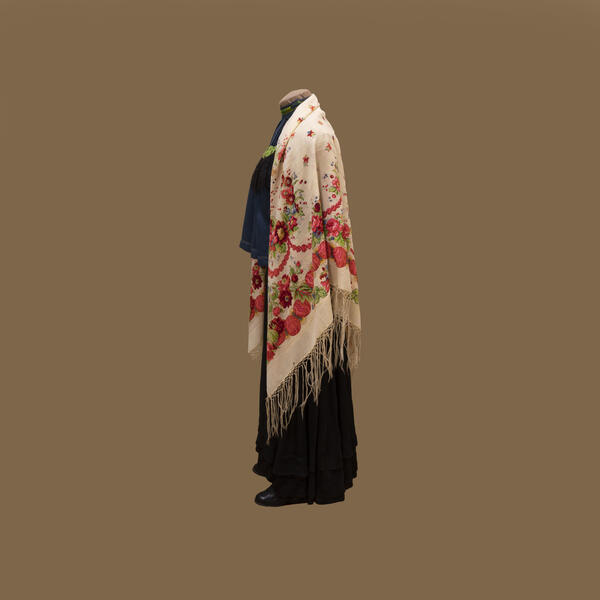This traditional beige female headscarf with embroidery is made of thin wool. It is decorated with bright beads and red flowers with blue elements. There are also emerald and pale green leaves. The edges of the headscarf have long fringes of the same color as the main cloth.
Traditionally, a Cossack woman had to put on a kerchief or other headgear when going out. A woman without a headscarf was scornfully called “uncovered”. Showing up bare-headed was a sign of ignorance and barbarism. Moreover, a woman was not allowed to enter a church like this.
The headscarf or kerchief was worn according to the marital status: a married Cossack woman always had to wear headgear and had a wide variety of headscarves. There was a superstition that female hair possessed magic powers and could attract lightning strikes during rain. At home, women put on headscarves when cooking and praying, while old women never took off their headscarves even when going to bed.
Headscarves were always in fashion. In everyday life, women wore simple headgear (made of sackcloth with textured patterns along the edges), or headscarves with wool fringes, ones made of printed calico (with blue, yellow, green, and black flowers against a red background). Headscarves were also made of red, green, blue, or yellow satin and silk, in small or large check (with tassels along the edges). Women also wore elegant lace headscarves.
Don Cossack women had a wide range of headgear for every occasion: for haymaking, weddings, funerals, gatherings, for wearing on Sunday, or under a shawl; for summer, spring, fall, and winter; for everyday wear, festivities, and mourning. When going out in spring and fall, Cossack women put on large headscarves — beautiful silk ones, ornamented Turkish scarves, and thin cashmere kerchiefs with bright flowers and fringes.
There were various ways of tying the headscarves: small ones were tied below the chin, while large kerchiefs were used to cover the forehead, cheeks, and neck, with two ends tied behind the neck. Large, beautiful headscarves were tied with the forehead left uncovered. A kerchief was folded in half with one end wrapped around the neck and tucked in without tying. The other end was beautifully straightened out in front, while the corner of the kerchief covered almost the entire back. This method was the best to reveal the beauty of this headgear.
In his novel “And Quiet Flows the Don”, Mikhail Sholokhov often mentioned headscarves as an element of traditional Cossack clothing.
Traditionally, a Cossack woman had to put on a kerchief or other headgear when going out. A woman without a headscarf was scornfully called “uncovered”. Showing up bare-headed was a sign of ignorance and barbarism. Moreover, a woman was not allowed to enter a church like this.
The headscarf or kerchief was worn according to the marital status: a married Cossack woman always had to wear headgear and had a wide variety of headscarves. There was a superstition that female hair possessed magic powers and could attract lightning strikes during rain. At home, women put on headscarves when cooking and praying, while old women never took off their headscarves even when going to bed.
Headscarves were always in fashion. In everyday life, women wore simple headgear (made of sackcloth with textured patterns along the edges), or headscarves with wool fringes, ones made of printed calico (with blue, yellow, green, and black flowers against a red background). Headscarves were also made of red, green, blue, or yellow satin and silk, in small or large check (with tassels along the edges). Women also wore elegant lace headscarves.
Don Cossack women had a wide range of headgear for every occasion: for haymaking, weddings, funerals, gatherings, for wearing on Sunday, or under a shawl; for summer, spring, fall, and winter; for everyday wear, festivities, and mourning. When going out in spring and fall, Cossack women put on large headscarves — beautiful silk ones, ornamented Turkish scarves, and thin cashmere kerchiefs with bright flowers and fringes.
There were various ways of tying the headscarves: small ones were tied below the chin, while large kerchiefs were used to cover the forehead, cheeks, and neck, with two ends tied behind the neck. Large, beautiful headscarves were tied with the forehead left uncovered. A kerchief was folded in half with one end wrapped around the neck and tucked in without tying. The other end was beautifully straightened out in front, while the corner of the kerchief covered almost the entire back. This method was the best to reveal the beauty of this headgear.
In his novel “And Quiet Flows the Don”, Mikhail Sholokhov often mentioned headscarves as an element of traditional Cossack clothing.




